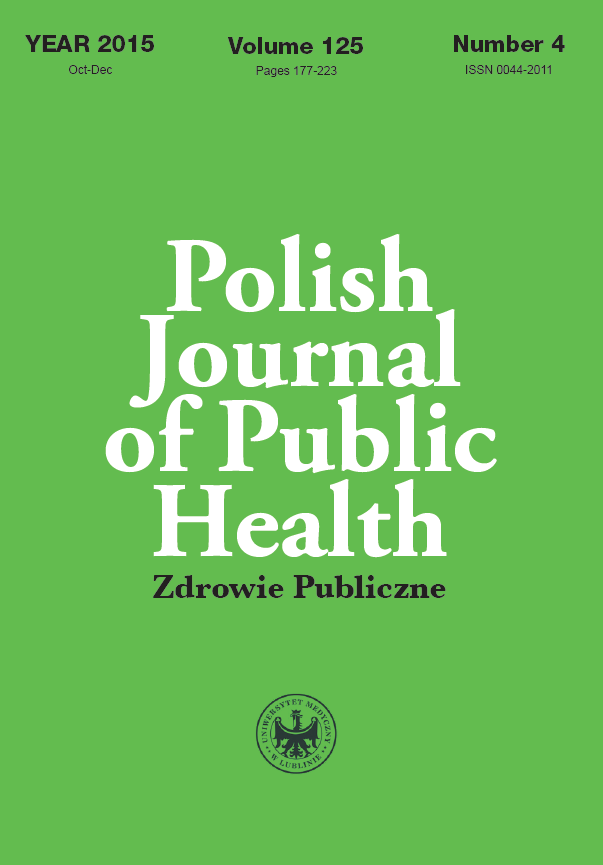Report on the first year of applying initial assessment of nutritional status in hospital inpatients
DOI:
https://doi.org/10.1515/pjph-2015-0057Keywords:
Body Mass Index, diet, malnutrition, screening, Subjective Global AssessmentAbstract
Introduction. Since 2012, Polish hospitals are recommended to implement the assessment of the nutritional status and appoint nutrition support teams.
Aim. To evaluate the application of initial assessment of inpatients’ nutritional status in the first year of its implementation in clinical practice.
Material and methods. A retrospective analysis of medical documentation of patients admitted to hospital in the year 2012 was conducted. The research sample included one in ten medical records.
Results. A total of 433 medical records was analyzed. In 5.3% medical records a lack of duly completed Subjective Global Assessment questionnaires was revealed. In 81.8% cases a calculated Body Mass Index (BMI) was not found. No instances of renewed calculation of BMI were recorded. In 49.7% cases no information on diet recommended to the inpatient was found. With the exception of the internal medicine ward, in 87% of the cases the diets were not recommended in writing by a physician or included in the medical orders documentation. The inpatients classified as undernourished were usually recommended a diet containing 2000 kcal + additional 300 kcal as second breakfast and afternoon snack. Information on cooperation with the nutrition support team and on inpatient’s nutrition was not included in the nursing documentation.
Conclusions. During the first year when the obligatory patient nutritional status assessment was introduced in Polish hospitals, the awareness of its significance, nutritional therapy planning and monitoring of the results were insufficient. The assessment of nutritional status seems to be another dead letter in patient medical documentation.
References
1. Jarosz M, Respondek W. Wpływ stanu odżywienia na skuteczność i koszty leczenia. In: M. Jarosz (ed). Zasady prawidłowego żywienia chorych w szpitalach. Warszawa: Instytut Żywności i Żywienia; 2011. p. 26-31.
2. Freijer K, Tan SS, Koopmanschap MA, et al. The economic costs of disease related malnutrition. Clin Nutr. 2013;32:136-41.
3. Kondrup J, Allison SP, Elia M, et al. ESPEN guidelines for nutrition screening 2002. Clin Nutr. 2003;22:415-21.
4. Lindorff-Larsen K, Rasmussen HH, Kondrup J, et al. The Scandinavian Nutrition Group. Management and perception of hospital undernutrition – a positive change among Danish doctors and nurses. Clin Nutr. 2007;26:371-8.
5. Szczygieł B. Leczenie żywieniowe – postępy 2011. Med Prakt Chir. 2012;3:25-31.
6. Hamirudin AH, Charlton K, Walton K, et al. ‘We are all time poor’ – is routine nutrition screening of older patients feasible? Aust Fam Physician. 2013;42:321-6.
7. Lamb CA, Parr J, Lamb EIM, Warren MD. Adult malnutrition screening, prevalence and management in a United Kingdom hospital: cross-sectional study. Brit J Nutr. 2009;102:571-5.
8. Singh H, Watt K, Veitch R, et al. Malnutrition is prevalent in hospitalized medical patients: are housestaff identifying the malnourished patient? Nutrition 2006;22:350-4.
9. Naithani S, Thomas JE, Whelan K, Morgan M, Gulliford MC. Experiences of food access in hospital. A new questionnaire measure. Clin Nutr. 2009;28:625-30.
10. Agarwal E, Ferguson M, Banks M, et al. Nutritional status and dietary intake of acute care patients: results from the Nutrition Care Day Survey 2010. Clin Nutr. 2012;31:41-7.
11. Pertkiewicz M. Niedożywienie i jego następstwa. Post Żyw Klin. 2008;2:4-8.
12. Detsky AS, McLaughlin JR, Baker JP, et al. What is subjective global assessment of nutritional status? J Parenter Enteral Nutr. 1987;11:8-13.
13. Kyle UG, Kossovsky MP, Karsegard VL, Pichard C. Comparison of tools for nutritional assessment and screening at hospital admission: a population study. Clin Nutr. 2006;25:409-17.
14. Poulia KA, Yannakoulia M, Karageorgou D, et al. Evaluation of the efficacy of six nutritional screening tools to predict malnutrition in the elderly. Clin Nutr. 2012;31:378-85.
15. Hesselink G, Schoonhoven L, Plas M, et al. Quallity and safety of hospital discharge: a study on experiences and perceptions of patients, relatives and care providers. Int J Quality Health Care. 2013;25:6-74.
Downloads
Published
Issue
Section
License
Copyright (c) 2016 Polish Journal of Public Health

This work is licensed under a Creative Commons Attribution-NonCommercial-NoDerivatives 3.0 Unported License.


